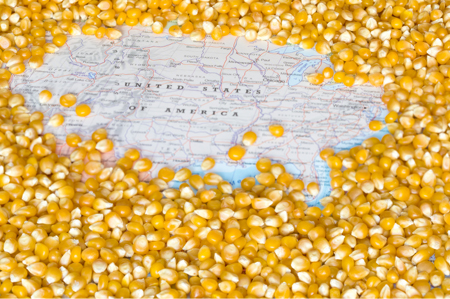Smaller Crops Boost Prices
Category: Grains

(Farm Futures) – Grain futures are higher this morning after USDA surprised the market by cutting its estimate of both corn and soybean production. Analysts were expecting moderate increases in production of both crops, causing prices to move moderately higher immediately following the release of the agency’s latest World Agricultural Supply and Demand Estimates (WASDE) report.
“USDA surprised the market, and finally, in a good way for farmers,” says Farm Futures senior grain market analyst Bryce Knorr. “The agency’s cuts to the size of the corn and soybean crops, while modest, are a much-needed shot of bullish news that could help futures continue the rally off September lows.”
Knorr notes that big speculators remain short, so the latest WASDE report may encourage them to buy back bearish bets on fears that production will turn smaller still after USDA tallies damage from recent heavy rains in the central U.S.
“But it’s important for growers not to read too much into today’s gains,” he warns. “Remember, in years of normal production both corn and soybeans have trouble extending rallies into November. Producers should be on the lookout for opportunities to hedge inventory they expect to store on farm, selling still decent carry in futures. And corn growers selling into the river system should be vigilant if basis pushes develop, because corn basis could tighten faster than soybeans this year due to China’s tariffs.”
Corn
USDA lowered its estimates for 2018 U.S. corn production from September estimates of 14.827 billion bushels down to 14.778 billion bushels. Analysts expected that number to move higher, to 14.859 billion bushels. The agency moved per-acre bushel estimates lower as well, from 181.8 bushels per acre a month ago to 180.7 bpa. Farm Futures, which regularly participates in pre-report estimates, offered projections of 14.905 billion bushels in total production on average per-acre yields of 182.0 bpa. Harvested acres remained unchanged, at 81.8 million acres.
USDA moved 2018/19 U.S. corn ending stocks higher, meantime, moving that number from September estimates of 1.774 billion bushels up to 1.813 billion bushels. Analysts expected a larger increase to 1.913 billion bushels, however.
World ending stocks moved moderately higher for both 2017/18 and 2018/19. USDA moved year’s ending stocks from 194.2 million metric tons in September to 198.21 MMT. Analysts expected a more modest increase to 194.8 MMT. For 2018/19, USDA has world ending stocks for corn moving from 157.0 MMT in September up to 159.35 – very close to analyst expectations of 159.2 MMT.
USDA left its average season price for corn unchanged from a month ago, with a range of $3.00 to $4.00 per bushel.
Is the latest data dump enough incentive for U.S. farmers to plant more acres next year? Knorr says it’s probably too early to tell – for now.
“Corn may need to rally a bit this winter to convince growers to plant enough acres in 2019, but that’s a story the market will discuss down the road,” he says.
Soybean
USDA also fractionally lowered its 2018 U.S. soybean production estimates from 4.693 billion bushels in September down to 4.690 billion bushels in today’s WASDE report. Analysts expected the latest soybean production figures to reach 4.702 billion bushels, including a Farm Futures estimate of 4.690 billion bushels.
The agency did raise its per-acre soybean yield estimates from 52.8 bpa last month to 53.1 bpa – nearly in line with analyst estimates of 53.3 bpa, including a nearly on-the-nose offering by Farm Futures of 53.0 bpa. Harvested area estimates dropped by 400,000 acres to reach 88.3 million acres.
U.S. soybean ending stocks for 2018/19 moved higher, from 845 million bushels in September to 885 million bushels. Analysts generally expected a bigger increase, with an average estimate of 905 million acres.
World ending stocks for soybeans saw mixed results for 2017/18 and 2018/19. This year’s world ending stocks moved from September estimates of 94.7 MMT down to 96.65 MMT in the October WASDE report. But 2018/19 world ending stocks moved higher, from September estimates of 108.3 MMT up to 110.04 MMT in October.
USDA did not change its season-average price for soybeans, with a range of $7.35 to $9.35 per bushel.
Heading into 2019, Knorr says the trade dispute with China – normally the top buyer for U.S. soybeans – remains the No. 1 concern for the soybean market. Even so, soybean demand could be modestly better than expected, even if China doesn’t soon return to the negotiating table, he says.
“Low-priced U.S. soybeans are a bargain that end-users around the world won’t want to pass up, especially if any weather problems show up over the next few months in South America,” he says. “It’s early, but parts of Argentina are starting to trend drier, and eastern Brazil is also lacking moisture for planting.
However, even with better exports, leftover U.S. supplies could top 800 million bushels, which would represent a very burdensome number, Knorr says.
Wheat
U.S. wheat ending stocks moved higher, from 935 million bushels in September to 956 million bushels. Analysts expected that number to come in slightly higher, with an average guess of 959 million bushels.
But world ending stocks for 2018/19 eased from September estimates of 261.3 MMT down to 260.18 MMT for October. Analysts generally expected a much smaller drop, with an average estimate of 261.2 MMT, although Farm Futures’ estimate came in much closer at 260.0 MMT.
USDA narrowed its season-average price estimates for wheat, tightening the range to $4.80 to $5.40 per bushel.
“USDA raised its estimate of wheat ending stocks as expected, but the agency didn’t adjust its forecast of exports,” Knorr says. “The very slow start to shipments in the first four months of the 2018 marketing year may be too big a deficit to overcome.”
Too much rain for seeding hard red winter wheat on the Southern Plains may be wheat’s best hopes for breaking out of its recent stalemate, he adds.




